Sharks have roamed the oceans for hundreds of millions of years, with some species dating back to the age of dinosaurs. Among these ancient creatures are a few shark species that have survived almost unchanged, each with unique adaptations that help them thrive in diverse marine environments. From the mysterious depths of the ocean to warmer coastal waters, they showcase impressive lifespans and fascinating traits. Here’s a look at some of the oldest shark species still swimming our seas today, each with its own story of resilience and survival.
Sand Tiger Shark
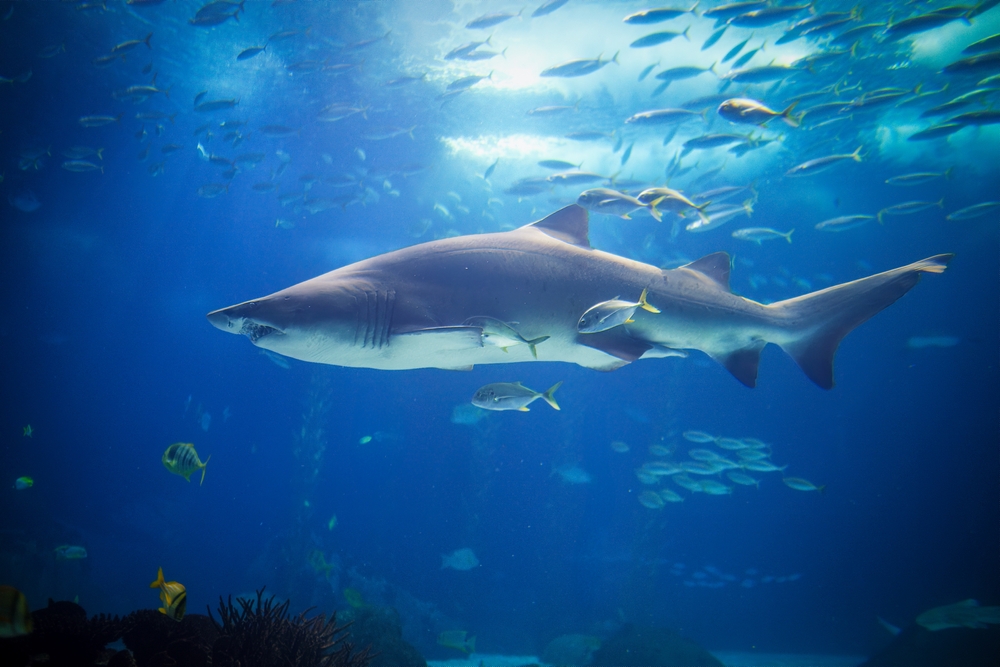
The Sand Tiger Shark (Carcharias taurus), despite its fierce appearance, is generally docile and has been around for roughly 100 million years. Inhabiting temperate and subtropical waters, it is commonly found off the coasts of North America, Japan, and Australia. It can grow up to 3.2 meters long and is known for its distinctive sharp teeth, which protrude even when its mouth is closed. They are unique for their method of buoyancy control, as they gulp air at the water’s surface. They are also ovoviviparous, with embryos that cannibalize each other in the womb, resulting in only one or two pups per pregnancy. They have a lifespan of around 20 years, and their population has declined due to overfishing. Its unique dentition makes it highly effective at trapping and holding onto prey. In recent years, efforts to conserve it have increased, with certain regions implementing protective regulations. Its tolerance for captivity has also made it a common species in aquariums, helping educate the public.
Frilled Shark
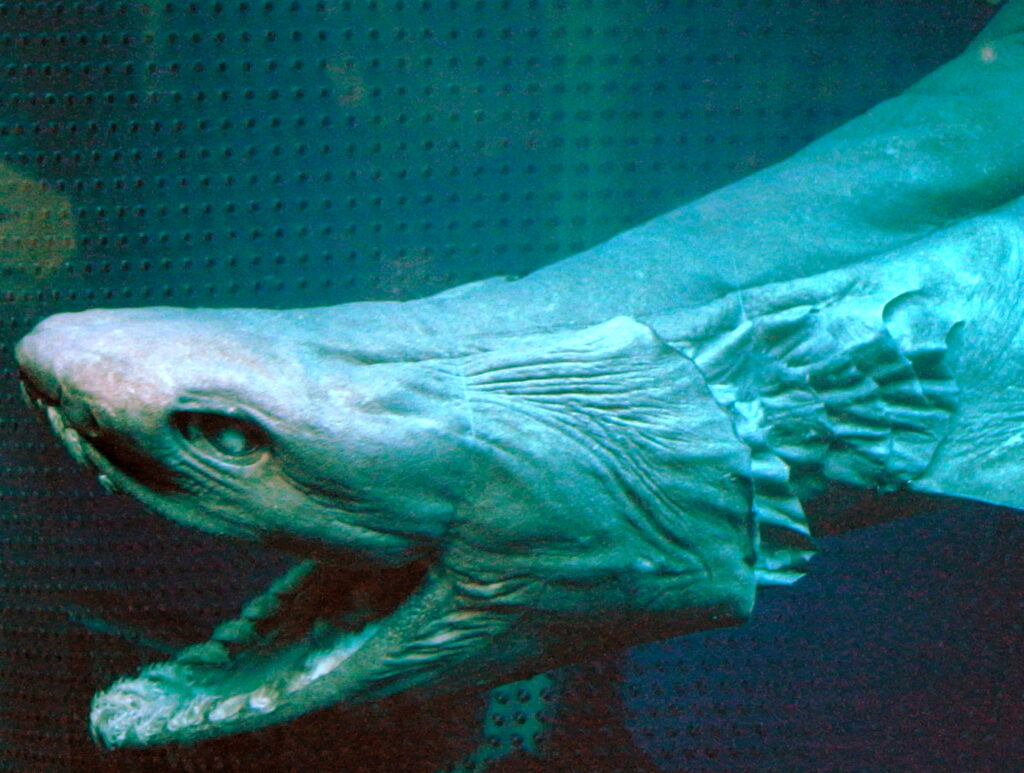
The Frilled Shark (Chlamydoselachus anguineus) is another ancient species dating back around 80 million years, often called a “living fossil” due to its prehistoric features. Found in the Atlantic and Pacific Oceans at depths of up to 1,500 meters, it has a snake-like body with frilly gills, lending to its name. They can reach lengths of up to 2 meters, and they consume squid, fish, and other sharks. Their slow metabolism and low activity rate are adaptations to the deep-sea environment, where food can be scarce. They are ovoviviparous, meaning they give birth to live young, a trait believed to enhance survival in deep-sea habitats. They have a lifespan of approximately 25 years, though their remote habitats make study difficult. Its flexible jaw allows it to swallow prey whole, a unique adaptation among sharks. Recent discoveries have found that they can survive in varying temperature zones, showcasing their resilience. Its teeth, arranged in multiple rows, are specialized for grasping slippery prey effectively.
Thresher Shark
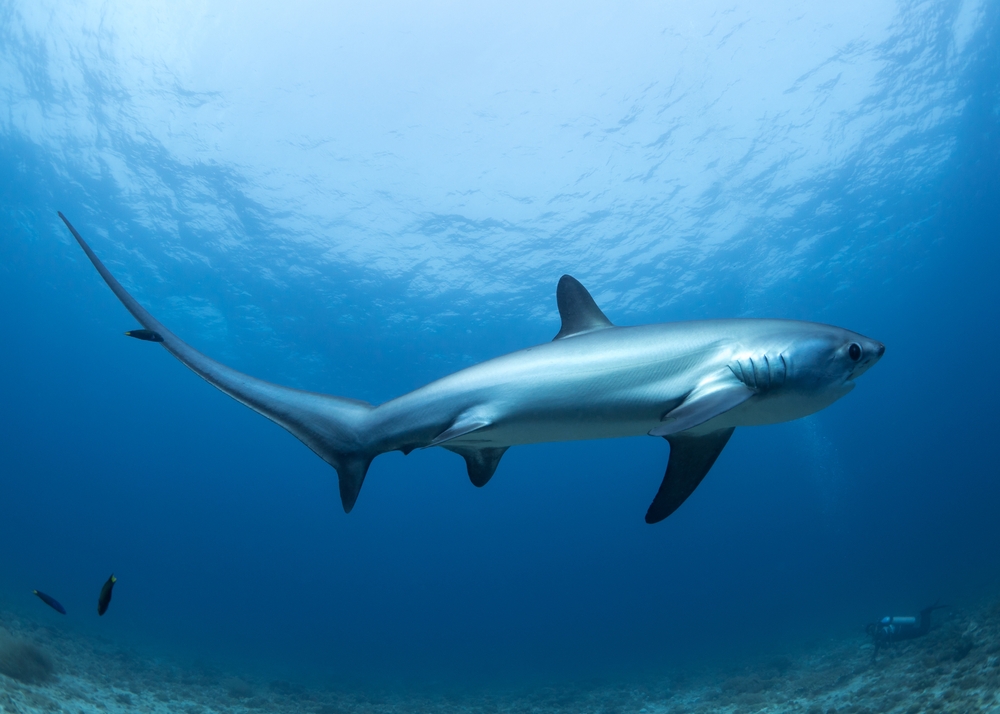
The Thresher Shark (Alopias vulpinus) is known for its distinctively long tail, which it uses to stun prey, and has existed for over 55 million years. They can be found in temperate and tropical oceans around the world, from the Atlantic to the Indo-Pacific regions, often at depths of 500 meters. They can reach lengths of up to 6 meters, with their tail comprising about half of their total body length. They are primarily solitary and are known to prey on schools of fish, squid, and crustaceans. Their lifespan averages around 20 years, though some individuals have been known to live up to 30 years in ideal conditions. They are ovoviviparous, meaning young develop inside eggs within the mother’s body, leading to live births. The unique hunting technique of this shark, using its tail, is a rare and effective method in the shark world. They face threats from fishing industries due to their high-value meat and fins. Conservation efforts have been made to protect this species, as its numbers have significantly declined over recent decades.
Spiny Dogfish
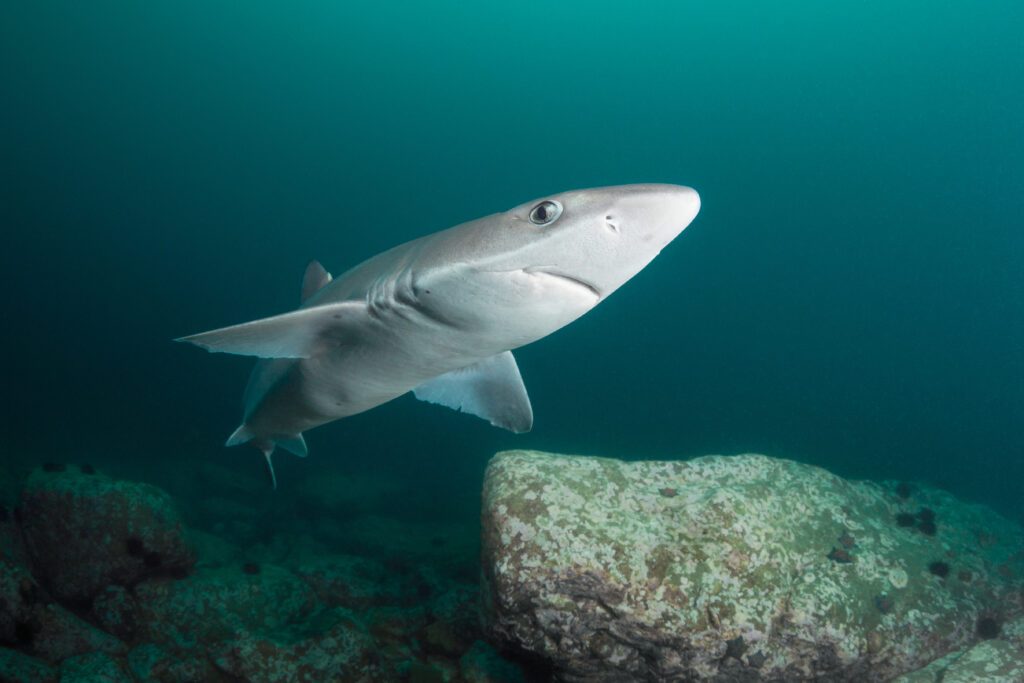
The Spiny Dogfish (Squalus acanthias) is a small, ancient shark species that has existed for over 100 million years and is found in temperate waters worldwide. Typically measuring about 1 meter in length, they are named for the sharp spines located in front of their dorsal fins, which they use as a defense mechanism. They are social creatures and often travel in large schools, feeding on fish, squid, and crustaceans. They have an impressive lifespan, with some individuals reaching up to 50 years. Unlike many shark species, they mature slowly and have a long gestation period of up to 24 months. They are ovoviviparous, with females giving birth to live young after a lengthy pregnancy, which helps ensure their survival in the wild. Their slow growth and long lifespan make them particularly vulnerable to overfishing. Efforts to protect their populations have been implemented, especially in areas where they are heavily fished. This species has been studied extensively due to its long life and unique reproductive cycle.
Basking Shark
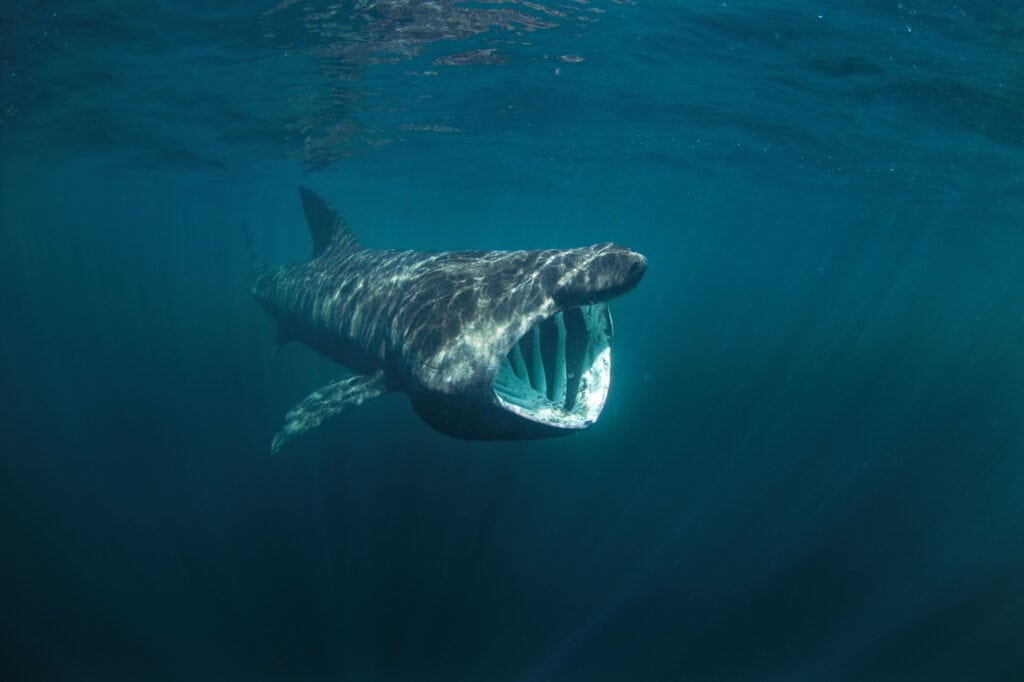
The Basking Shark (Cetorhinus maximus) is the second-largest fish in the world, often reaching up to 10 meters in length, and is believed to have existed for over 30 million years. Found in temperate oceans worldwide, they are known for their slow swimming and passive filter-feeding habits. They primarily consume plankton, filtering vast amounts of water through their gills as they move. They are known for their seasonal migrations and are often spotted near the surface, “basking” in the sun, hence their name. They can live up to 50 years, though many aspects of their life cycle remain unknown due to their elusive nature. They are ovoviviparous, with young developing in egg cases inside the mother’s body. They are considered vulnerable due to targeted fishing for their fins, liver oil, and meat. Conservation efforts are in place in several countries to protect them, including protected areas and regulations on fishing practices. This species plays a crucial role in marine ecosystems due to its filter-feeding habits.
Goblin Shark
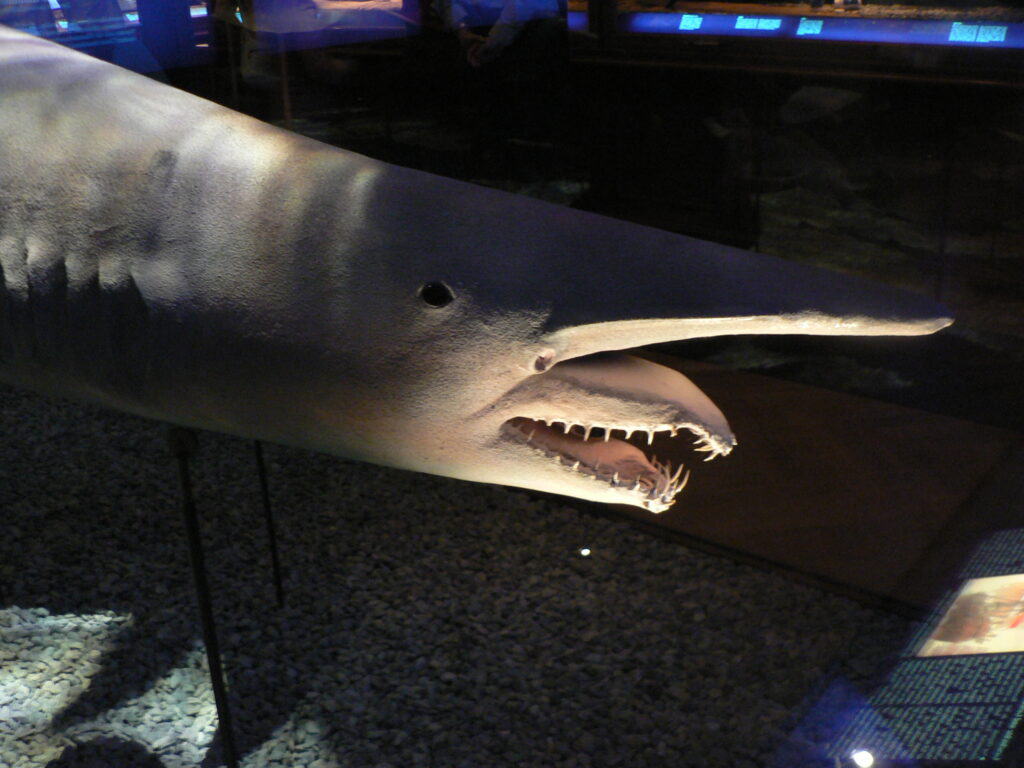
The Goblin Shark (Mitsukurina owstoni) is one of the most ancient and mysterious shark species, with fossil records suggesting it dates back over 125 million years. Known for its distinctive, elongated snout and retractable jaws, this deep-sea predator lives in depths of 100 to 1,300 meters. Its pinkish-gray coloration, combined with a slender, flexible body, helps it blend in the dark ocean environment. They primarily inhabit the waters of the Atlantic, Pacific, and Indian Oceans, especially around Japan and South Africa. They can live up to 60 years, though little is known about their life cycle and breeding habits. They are considered “living fossils” due to their primitive features, which have remained relatively unchanged. It is elusive, rarely seen by humans, contributing to its enigmatic reputation. Additional studies on its diet suggest it feeds on fish, cephalopods, and crustaceans, capturing prey with swift jaw extension. Despite their ancient lineage, they show adaptability in various deep-sea environments worldwide.
Whale Shark
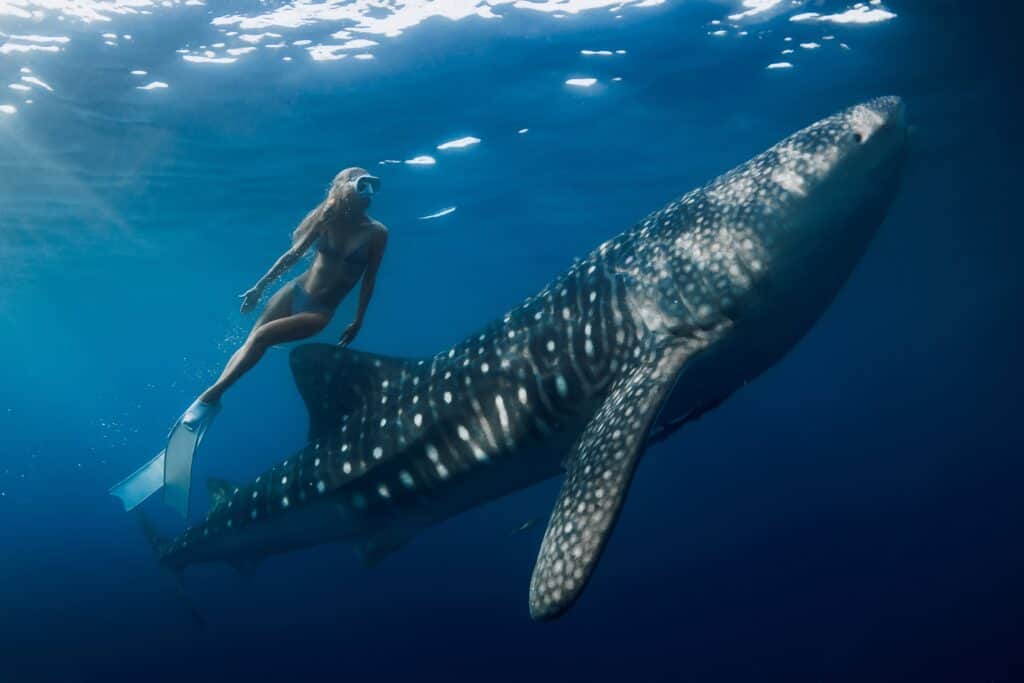
The Whale Shark (Rhincodon typus), the largest fish in the ocean, can reach lengths of up to 12 meters and has been swimming the seas for roughly 60 million years. Found in tropical and warm-temperate seas, these gentle giants are filter feeders, primarily consuming plankton, small fish, and crustaceans. They are known for their distinct spotted patterns and broad, flat heads, often seen near the surface in nutrient-rich waters. This species can live up to 70 years, although some individuals are believed to reach around 100 years. They are ovoviviparous, with females giving birth to live young that are ready to swim immediately. They are slow-growing and reach sexual maturity at a later age, which has implications for their conservation. Despite their size, they are peaceful creatures that pose no threat to humans. They are protected in many parts of the world due to overfishing and habitat destruction, and ecotourism has helped raise awareness of their conservation needs. Their long lifespan and unique characteristics make them a highly valued species for marine research.
Sixgill Shark
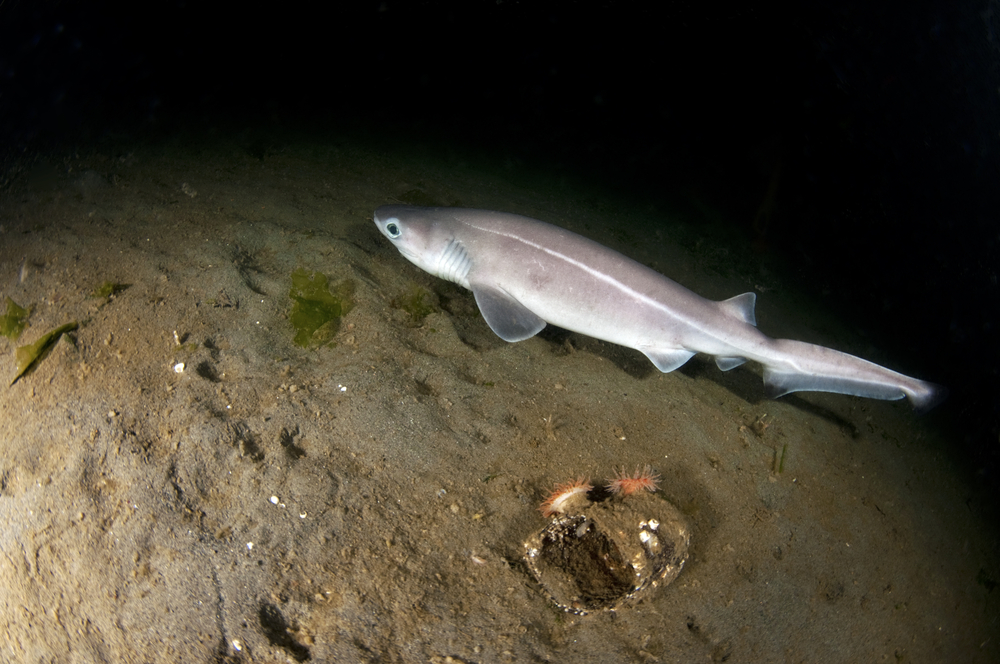
The Sixgill Shark (Hexanchus griseus), also known as the Bluntnose Sixgill, is a prehistoric species estimated to have existed for over 200 million years. It is found in temperate and tropical waters worldwide, residing in depths of 200 to 2,500 meters. Known for its six gill slits, a trait uncommon in modern sharks, it has a broad, rounded head and can reach lengths of up to 5 meters. It is estimated to live up to 80 years. It feeds on a diverse diet, including fish, crustaceans, and marine mammals. Its nocturnal behavior allows it to hunt effectively in the deep-sea environment. They are ovoviviparous, giving birth to live young in secluded environments. They are generally slow-moving, though they can exhibit bursts of speed when needed. This species is capable of thriving across various ocean depths, from continental shelves to abyssal plains. Its ancestry connects it to ancient sharks that once roamed shallow seas over 200 million years ago.
Great White Shark
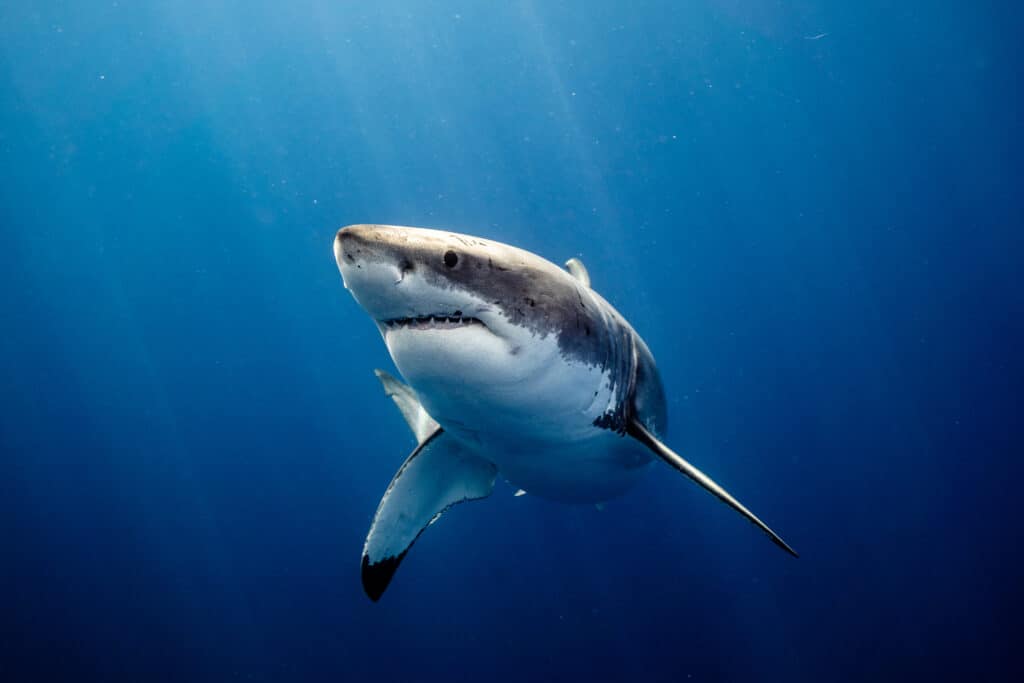
The Great White Shark (Carcharodon carcharias) is one of the most recognized and ancient shark species, existing for around 16 million years. Found in coastal and offshore waters worldwide, especially near the coasts of the United States, South Africa, and Australia, they are known for their size, reaching lengths of up to 6 meters. They are apex predators, feeding on fish, seals, and even whales, and play a vital role in marine ecosystems. They can live up to 70 years, with some individuals potentially reaching over 80 years in ideal conditions. This species is ovoviviparous, meaning pups are born live after developing inside egg cases within the mother. They have a slow growth rate and reach sexual maturity around 15 years of age. Despite their reputation, they are often cautious around humans and avoid confrontation. They face threats from illegal hunting, bycatch, and pollution, which have led to conservation efforts worldwide. Their longevity and position as top predators make them essential to maintaining ocean health.
Greenland Shark
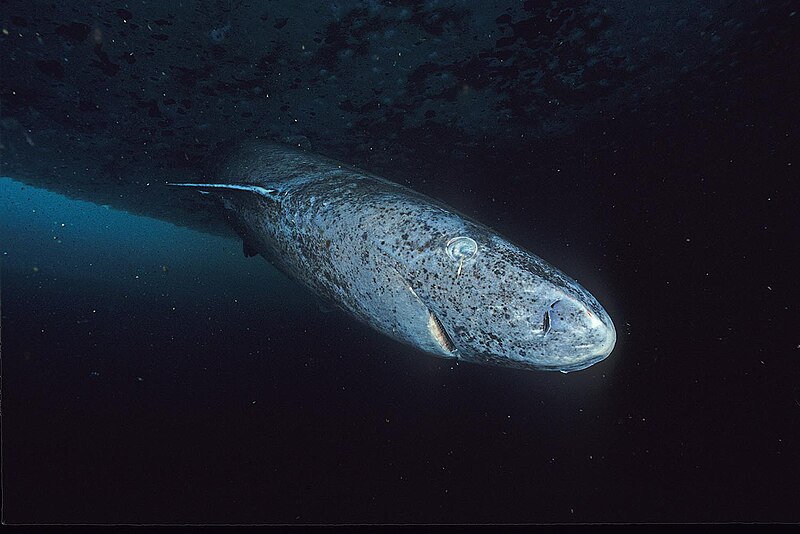
Hemming1952
/ Wikimedia Commons
The Greenland Shark (Somniosus microcephalus) is one of the oldest living vertebrates, with lifespans estimated to exceed 400 years. Found primarily in the Arctic and North Atlantic Oceans, this species prefers cold, deep waters, often residing at depths of up to 2,200 meters. They grow very slowly, reaching up to 7 meters in length, and are known for their lethargic behavior. They have a varied diet, eating fish, seals, and even carrion, and they can live at near-freezing temperatures. The species has a unique tolerance to cold and low-oxygen conditions, allowing it to thrive where few others can. Unlike many sharks, it is believed to reach sexual maturity only after around 150 years. Their flesh contains toxic compounds, which indigenous Arctic communities neutralize through a lengthy preparation process. Its eyes are often parasitized by a bioluminescent copepod, affecting its vision yet providing potential camouflage. Its incredible longevity is linked to its slow metabolism and frigid environment.
This article originally appeared on Rarest.org.
More from Rarest.org
19 Most Elusive Classic Motorcycles Ever Made

Classic motorcycles have an undeniable allure, and some of them remain the ultimate trophies for collectors. Their scarcity, groundbreaking engineering, and cultural significance make them highly sought after. Read More.
10 Beautifully Preserved Ancient Cities Buried Beneath the Earth

Ancient cities hold mysteries of civilizations long gone, hidden beneath the earth for centuries. These cities, once bustling with life, are now beautifully preserved time capsules of history. Read More.
21 Magnificent Mammals with Unique Fur Patterns

Nature’s creativity shines through the stunning fur patterns of certain mammals, making them stand out in their habitats. From stripes to spots, these unique designs help with camouflage, identity, and even temperature regulation. Read More.
